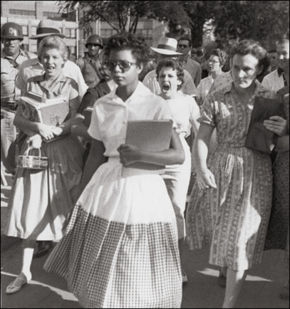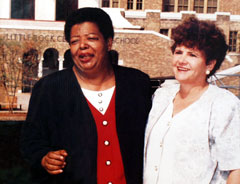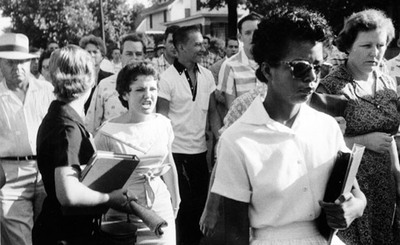Fascinating article should be read here at Vanity Fair. It focuses on this famous iconic picture:
The picture was taken on September 4, 1957.
The black girl is Elizabeth Eckard, one of the Little Rock Nine, the group of black students who attempted to go to school in one of the first desegregated high schools in the South.
Standing behind her, taunting her with insults, was a student at the high school. Her name is Hazel Bryan.
A painfully shy girl, Elizabeth arrived earlier than the rest of the Nine that day, and was "welcomed" by reporters and a large hostile crowd:
Elizabeth’s knees started to shake. She walked toward Central’s main entrance and tried a third time; again, the soldiers blocked her way, but this time told her to cross the street. Now the crowd fell in behind her, shouting: "Lynch her! Lynch her!" "No nigger bitch is going to get in our school! Get out of here!" "Go back to where you came from!" Looking for a friendly face, she turned to an old woman, who spat on her. Before long, some 250 whites were at her heels. She knew she couldn’t go back the way she’d come. But if she could only get to the bus stop a block ahead, she thought, she would be safe. She wanted to run, but thought she might fall down… "Lynch her!" someone shouted. "Send that nigger back to the jungle!"
 One of Elizabeth’s tormentors was Hazel Bryan, a junior at the high school:
One of Elizabeth’s tormentors was Hazel Bryan, a junior at the high school:
Hazel, her eyes narrowed, her brow furrowed, her teeth clenched as if about to bite, shrieked: "Go home, nigger! Go back to Africa!" Click.
The pictures show here were taken by an Arkansas Democrat photographer, Will Counts.
Elizabeth made it back to the bus stop and sat on a bench with the angry mob around her. Reporters on the scene became human beings and protected her by forming a loose cordon around her, and making sure their cameras and microphones were trained on her.
With the help of an elderly (white) woman, Elizabeth got out of that hairy situation.
But what of Hazel?
As for Hazel, …she was "rather pleased with herself"—so much so that two days later, she was in front of Central again, telling reporters that no way would she attend an integrated Central High School. "Whites should have rights, too!" she barked at a television camera, as [Hazel’s friends] Mary Ann and Sammie Dean looked on with approval. "Nigras aren’t the only ones that have a right!" At first, [Central High Vice Principal, Ellizabeth] Huckaby couldn’t place the screaming white girl in the picture, but she later remembered her from the previous winter: Hazel had played hooky to be with her boyfriend, and had failed some courses. The school notified her parents; her father said he did not want to beat her, but sometimes couldn’t help himself. Hazel subsequently swallowed some poison, and was briefly hospitalized; Mrs. Huckaby sent a teacher to check on her. The story even made the papers.
Now Hazel was in them again, far more prominently, and the irate vice principal hauled her into her office. Hatred destroyed haters, the older woman said. Hazel only shrugged; "breath wasted," Mrs. Huckaby later wrote. And she was right: the following Monday, Hazel was at Central again, telling newsmen that had God really wanted whites and blacks to be together, "he would have made us all the same color." "The boys and girls pictured in the newspapers are hardly typical and certainly not our leading students," Mrs. Huckaby wrote her brother in New York. "The girl (with mouth open) behind the Negro girl is a badly disorganized child, with violence accepted in the home, and with a poor emotional history." Hazel’s parents promptly pulled her out of Central and put her in a rural high school closer to her home. America had seen its last of Hazel Bryan for the next 40 years—except, that is, for the picture, which popped up whenever Little Rock in the 1950s, or the civil-rights movement or race hatred, was recalled.
The years passed for both girls. And then:
Elizabeth, now 21, was visiting Little Rock in the summer of 1963 when she got a most surprising message. Someone had called whom she’d never heard of before. Her name was Hazel Bryan.
At 16, Hazel had married a schoolmate, Antoine Massery, then dropped out. But Hazel, by now the mother of two and living off a gravel road in South Little Rock, had an intellectually curious, independent streak: she chafed at the regimentation and racial intolerance of her church, for instance, and was eventually kicked out of it. Seeing Martin Luther King and the civil-rights protesters on television made her think of Elizabeth, and what she’d done to her six years earlier. Never mentioning it to her husband, she called the first Eckford in the phone book—Elizabeth’s grandfather—and left several messages for her. Finally, Elizabeth got back to her. "I just told her who I was—I was the girl in that picture that was yelling at her, that I was sorry, that it was a terrible thing to do and that I didn’t want my children to grow up to be like that, and I was crying," Hazel says.
Honestly, Elizabeth wasn’t sure just which girl Hazel was. Far from studying the picture, she avoided it; all those white people in it had merged. But she accepted Hazel’s apology, because she seemed to be sincere, because her grandfather and father urged her to, and because Hazel so clearly craved forgiveness.
Elizabeth had a hard life. She never completed college, had a broken engagement, couldn’t get a job, and ended up in the Army. After leaving that, she had two sons by two different man (neither of whom she married), and lived a quiet life of desparation. Her depression made it impossible for her to keep a job. This went on for over a decade, until a change in her medication started to turn things around.
In 1996, Oprah Winfrey did a show on the Little Rock Nine. And Elizabeth was one of the seven who came for the reunion. Also coming was Hazal Bryan:
Hazel Bryan Massery had three adult children and seven grandchildren. She had grown more prosperous—her husband had gone into antennae and satellite-TV installation—but also more unsettled. She had joined peace groups, done spiritual things, taken up belly dancing and screenwriting and feminism and performing as a clown. Much she did in secret, so that her husband couldn’t disapprove. On racial matters, she tried making amends, working with young black mothers-to-be and counseling minority students….
And there was a reunion:
Then, 40 years and a couple of weeks after their first encounter, Elizabeth and Hazel were together again. This time, they talked—about flowers and children and clothes. Hazel apologized to Elizabeth, thanked her for agreeing to meet…
And Will Counts, the photographer who, forty years earlier, had snapped thosee iconic pictures above was there — to take another picture of the two women in front of Little Rock’s Central High School:



